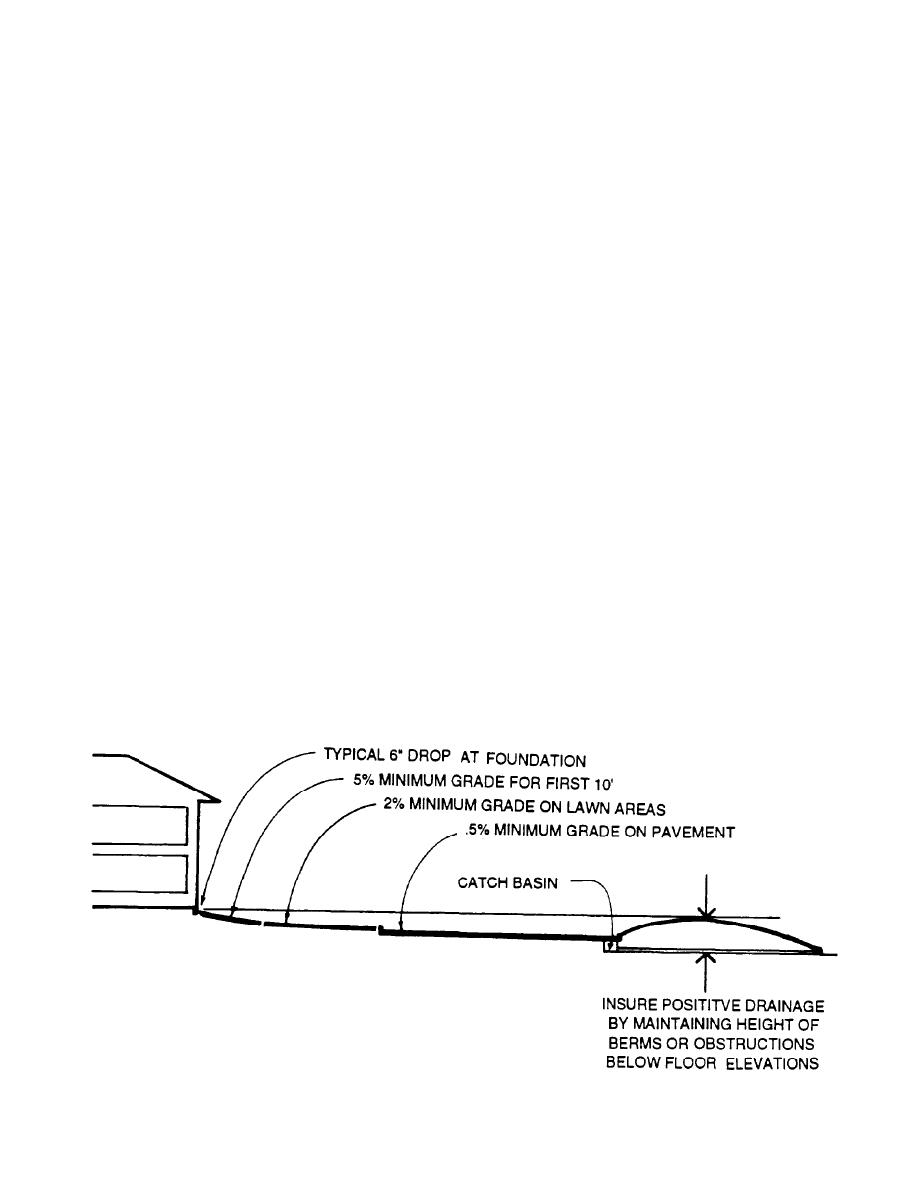
TM5-803-14
construction when the lack of drainage systems
c. Positive Drainage. The principles of positive
and vegetative cover make it difficult to control
drainage should be applied universally across the
stormwater flow. A pond can be coverted into a
site. Figure 4-16 illustrates the following basic
permanent site feature and serve as a site ame-
principles:
nity. Appropriate guidance for designing ponds
(1) Water should be moved away from struc-
should be obtained from local and state agencies.
tures.
(2) Water should not be allowed to pond at
Figure 4-17 illustrates detention and retention
ponds.
low points or in low areas.
(3) The finished floor elevations of buildings
4-6. Erosion Control.
should be sufficiently high that if drainage struc-
Erosion occurs as the result of a lack of vegetative
tures are blocked, the water will not back up into
cover, excessively steep slopes, excessive runoff, or
the buildings.
a combination of these factors. Erosion conditions
can be improved by: reducing grades, using geo-
controlled, captured and redirected, both natural
textiles, establishing or reestablishing vegetative
and mechanical methods can be used. Natural
cover, and introducing mechanical controls such as
means are preferable because they are less expen-
riprap and cribbing. Banks with steeper than 3:1
sive, require less maintenance, and fit more easily
slopes are discouraged because they increase the
into the natural landscape. Swales and grassed
rate of runoff and deter establishment of vegeta-
ditches can move moderate amounts of runoff
tive cover. If an area on site involves such steep
provided they observe minimum (1%) and maxi-
grades, then, realistically, mechanical means of
mum gradients. The maximum gradient is deter-
control, including retaining walls, should be ex-
mined by the velocity of the flow and the erodibil-
plored in the original design. Otherwise, mainte-
ity of the soil. When a minimum slope on a
nance problems will persist and eventually begin
grassed ditch is unattainable, paved ditches can be
to affect the site beyond the immediate problem
used on slopes as flat as 0.5%. When the quantity
area. Figure 4-18 illustrates methods of erosion
and speed of runoff is greater, the drainage chan-
control. The civil engineer and/or agronomist on
nel can also be paved, or check dams or weirs can
the design team should address erosion problems
be introduced to slow the water's movement.
and solutions.
e. Detention and Retention Ponds. Detention
ponds collect stormwater and detain it so that it
4-7. Climatological Conditions.
can be released from the site through a control
There are a variety of established techniques for
structure at a previously established rate of flow.
mitigating or improving climatological conditions
Retention basins collect stormwater on site and
on site. TM 5-803-13 provides specific guidance on
retain it until it is able to infiltrate the ground or
using plant material to deal with climatological
evaporate. Ponds are most commonly used during
Figure 4-16. Principles of Positive Drainage.
4-15



 Previous Page
Previous Page
